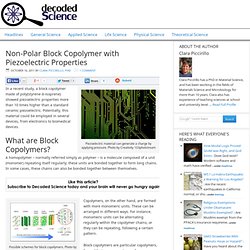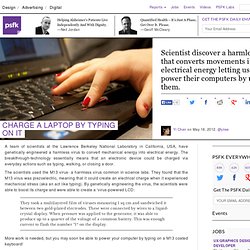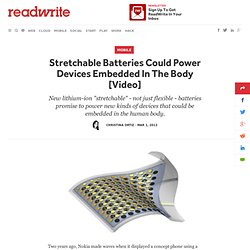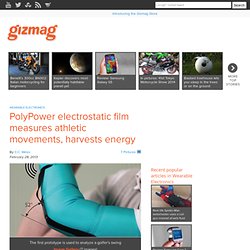

Chrome 网上应用店 - 首页. PiezoElectric Fabrics. PiezoElectric Auto Body Material. Non-Polar Block Copolymer with Piezoelectric Properties Piezoelectric material can generate a charge by applying pressure.

Photo by Creativity 103photstream In a recent study, a block copolymer made of poly(styrene-b-isoprene) showed piezoelectric properties more than 10 times higher than a standard ceramic piezoelectric. Potentially, this material could be employed in several devices, from electronics to biomedical devices. What are Block Copolymers? A homopolymer – normally referred simply as polymer – is a molecule composed of a unit (monomer) repeating itself regularly; these units are bonded together to form long chains. Possible schemes for block copolymers. Copolymers, on the other hand, are formed with more monomeric units. Block copolymers are particular copolymers, formed by two or more types of homopolymer chain bonded together. Piezoelectricity – Concept and Applications. Modeling and Simulation of Piezoelectric Energy Harvester Archive. Generator Produces Electricity By Harnessing Friction. Charge A Laptop By Typing On It. A team of scientists at the Lawrence Berkeley National Laboratory in California, USA, have genetically engineered a harmless virus to convert mechanical energy into electrical energy.

The breakthrough-technology essentially means that an electronic device could be charged via everyday actions such as typing, walking, or closing a door. The scientists used the M13 virus- a harmless virus common in science labs. They found that the M13 virus was piezoelectric, meaning that it could create an electrical charge when it experienced mechanical stress (aka an act like typing). By genetically engineering the virus, the scientists were able to boost its charge and were able to create a ‘virus-powered LCD: They took a multilayered film of viruses measuring 1 sq cm and sandwiched it between two gold-plated electrodes.
More work is needed, but you may soon be able to power your computer by typing on a M13 coated keyboard! Piezoelectric Energy Harvesting. Brenda Ou December 10, 2011 Submitted as coursework for PH240, Stanford University, Fall 2011 Introduction The search for a clean, reusable source of energy has caused a spike in interest in the exploration of piezoelectricity.

Further research into its uses has significantly increased in the last few years. Piezoelectric Device Harvests Wasted Heat Energy From Tech. When using devices such as laptops and phones, a certain amount of energy is always wasted via heat.

However, researcher Dr. Long Que at Louisiana Tech University has made a green tech breakthrough by creating a tool that can harvest energy from heat wasted by electronic gadgets. His piezoelectric device could potentially revolutionize the energy efficiency of our current gadgets. Image © qthrul. Stretchable Batteries Could Power Devices Embedded In The Body. Two years ago, Nokia made waves when it displayed a concept phone using a flexible OLED display.

Samsung and Ericsson have shown similar prototypes. So flexible devices and displays are on the market horizon. But they're still just a first step toward a new class of future devices that can not just flex, but actually stretch - so they can be safely and comfortably implanted in the body, for example. So what is the prognosis for these "stretchable" devices? Stretchable lithium-ion battery The "Stretch Armstrong" of Batteries It took Yonggang Huang and John A. Finally, they were able to come up with "pop-up" technology that allows the circuits to bend and twist. In a video (below), Huang and Rogers demo the battery by hooking it up to an LED light and slowly stretching it out. PolyPower electrostatic film measures athletic movements, harvests energy. Danish company Danfoss PolyPower A/S has designed a new wearable sports sensor that has the potential to measure everything from stance to force.

The sensor could prove a veritable technology on its own, but PolyPower technology is also being explored as a means of actuation and energy harvesting. View all PolyPower material is a proprietary version of Dielectric Electro Active Polymer (DEAP) technology. Margot Krasojevic - Project - Piezoelectric Canopy Playground. The Piezoelectric playground is a temporary structure designed for the Pioneers park in Belgrade, Serbia.
It will be used as a bandstand and playground. The canopy is a hyperbolic structure which folds in on itself draining rain water into the pool directly underneath it which diffracts light (acting as a prism) further magnifying the activities within the canopy structure. Clothing as a supercapacitor. Energy-Generating Knee Strap Could Spell the End of Batteries. Photo by Shutterstock Time for the energy industry to pull itself up by the knee straps: A group of scientists in the United Kingdom have developed a novel energy-harvesting device that attaches to the joint between the thigh and shin. Composed of piezoelectric materials , which generate power when they’re subjected to mechanical strain, the technology could spell self-powered heart monitors for athletes, lighter loads for soldiers, and gadgets that won’t run out of juice before you do.
The research, published in this month’s issue of , combines the expertise of scientists from Cranfield University , the University of Liverpool , and the University of Salford . The device itself is circular, with an outer ring and a central hub. When the knee joint goes through a walking movement, the outer ring rotates, causing the 72 plectra on its surface to “pluck” four energy-generating arms on the inner hub.
The best part? Piezoelectric.